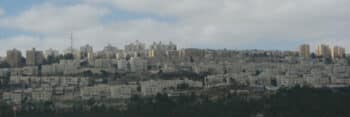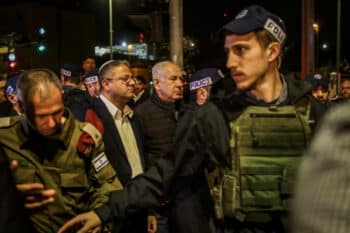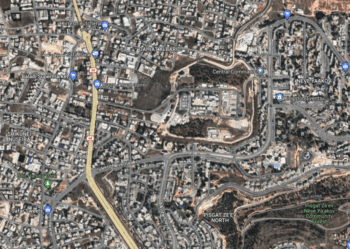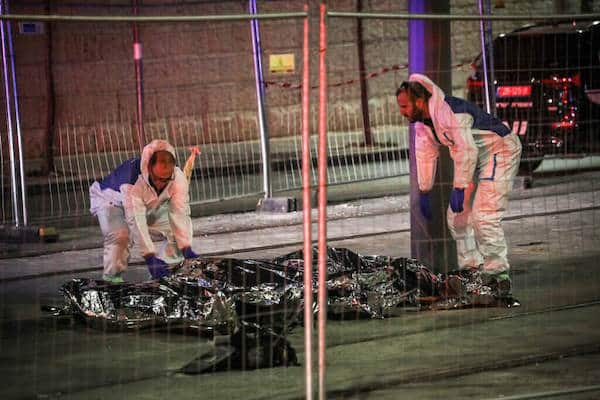The occupied Palestinian territory is going through some of the most violent, destructive, and lethal days in recent memory. The Israeli military occupation is metastasizing into a monster eating away at Palestinian life in all its shapes and forms. A sense of hopelessness, frustration, and despair hovers over us all like a dark cloud.
Then suddenly, one act of defiance pierces the dark, igniting a spark in the eyes of the people. A mourning tent in Jenin momentarily turns into a celebration. A street in Kufr Aqab is drowned in the sound of fireworks and beeping cars. Khairy Alqam’s fatal attack, where he shot and killed seven Israeli settlers in the Israeli settlement of Neve Yaakov, was one such moment.
It is hard to explain the fleeting spark people felt when they heard the news. I know for a fact that not one of us would delight in death. But to understand the events at Neve Yaakov and the Palestinian reaction to it, you need to understand its context–you need to understand the history of the place where it happened and the personal history of the person who carried it out.
The Israeli and international media, as well as political leaders, have attempted to turn the attack into a religiously-motivated crime because it took place on the eve of Shabbat in an area adjacent to a synagogue. But these same accounts ignore the fact that Neve Yaakov is also home to the Israeli military’s central command center for the occupation of the West Bank, and the settlement has been central to cementing Israeli control over occupied Jerusalem. Ignoring this context only works to dehumanize Palestinians.
When an attack like Khairy Alqam’s in Neve Yaakov occurs, you must understand that this violence does not occur in a vacuum.

A PHOTO OF THE ISRAELI SETTLEMENT NEVE YAAKOV TAKEN IN 2008. (PHOTO: WIKIMEDIA)
So here is the context.
Personal and political history
While none of us may ever truly know what drove Khairy Alqam to carry out an attack in Neve Yaakov on that Friday night, a personal motive may be deduced from his very name–he was named after his grandfather, a 51-year-old Jerusalemite who was killed by an Israeli settler in 1998. The settler who killed Alqam’s grandfather was Haim Ferelman, a follower of the proscribed Kach terrorist movement. Ferelman was released in 2010 when he was acquitted by an Israeli court of killing Khairy and three other Palestinians. Celebrating his release was another follower of the Jewish-supremacist Kach movement, Itamar Ben-Gvir, who now serves as Israel’s National Security Minister.
Beyond the personal dimension, there is the general circumstance of occupation and the encroachment of illegal settlements in East Jerusalem.
The attack took place in Neve Yaakov, an illegal settlement in occupied East Jerusalem. It did not take place in a “neighborhood of Jerusalem,” as some in the media have claimed. This matters because understanding the nature of Neve Yaakov as a settlement is crucial to understanding the event as a whole.
Neve Yaakov was established in 1972 on lands illegally expropriated by the Israeli occupation authorities earlier in April 1968 and August 1970. The lands seized belonged to two neighboring Palestinian towns, Beit Hanina (551 dunams) and Al-Ram & Dahiyeh Al-Barid (315 dunams), in addition to lands seized from the village of Hizma to the east (385 dunams).
The new settlement was constructed to absorb incoming Zionist immigrants from abroad. Many of those were from English-speaking countries, namely American Zionists, following plans presented by Kach leader Rabbi Meir Kahane.
Prior to the occupation of East Jerusalem in 1948, Palestinians in the area close to Neve Yaakov had known and recognized that Jews had already owned land in that area. Those were 62 dunams, bought in 1924 from Beit Hanina residents by an American religious Zionist movement known as “Mizrachi,” founded in 1902. In 1948, residents of Neve Yaakov abandoned the settlement with the onset of the Nakba, as the Jordanian Army mobilized against the Zionist takeover of Palestine.
Between 1948-1967, the Jordanian military established a military base at the site of the settlement, in a move that locals understood as Jordan’s way of preserving Jewish property from takeover during the time of Jordanian rule over the West Bank & East Jerusalem.
The settlement we see today is almost nowhere near what the old site was like. In fact, the settlement in its entirety is built on private and titled lands, whose Palestinian owners were never consulted or compensated before the hostile takeover.

ISRAELI PRIME MINISTER BENJAMIN NETANYAHU (CENTER R) AND ISRAELI MINISTER OF NATIONAL SECURITY ITAMAR BEN-GVIR (CENTER L) ARRIVE AT THE SITE OF A SHOOTING ATTACK IN NEVE YAAKOV, JANUARY 27, 2023. (PHOTO: OREN ZIV/DPA VIA ZUMA PRESS/APA IMAGES)
Neve Yaakov, along with neighboring settlements in East Jerusalem such as Ramot, Pisgat Ze’ev, and Pisgat Amir, were vital in Israel’s strategic plan to create a belt of Jewish-only settlements in the north of the occupied city, meant to choke Palestinian neighborhoods by ending the territorial contiguity between them and to prevent any potential natural expansion of those neighborhoods in the future. Neve Yaakov, along with other settlements in East Jerusalem, served the direct purpose of fragmenting and dividing the occupied city.
The settlement project in Jerusalem
Today, the consequences of Israel’s settlement project in East Jerusalem are felt by every Palestinian in the city. The town of Al-Ram was forcefully separated from Dahiyat Al-Barid with an 8-meter-high concrete wall, which was constructed in 2006. Residents were separated from their families and neighbors, as the wall literally came up in the heart of their town. Traveling 20-40 minutes through notorious military gates and checkpoints was required for next-door neighbors to visit each other.
The town of Hizma was blocked off from Jerusalem in its entirety, made into an effective ghetto by the apartheid wall and a military checkpoint inaccessible to any of its residents. It was then encircled by the Jewish-only settlements of Neve Yaakov, Pisgat Ze’ev, and Pisgat Amir.
In Beit Hanina, the neighborhood where I grew up, the effect was felt differently. The town was split into two parts, half of it behind the apartheid wall and designated as “Area B & C” of the West Bank, where Palestinian life and construction were severely restricted, and the other half absorbed into the Jerusalem Municipality, falling under direct Israeli rule after the annexation of occupied East Jerusalem in 1980. Most of Beit Hanna’s remaining lands (2,927 dunams) were expropriated for Jewish-only settlements, while Palestinians remained on only 2,368 dunams of built residential areas.
Getting permits to build homes for Palestinians in Beit Hanina is almost impossible. Those who build on their land or add extensions to their homes receive immediate demolition orders from Israeli authorities. In comparison, the settlers in East Jerusalem constantly receive new expansions to their settlements, while entirely new settlements are built specifically for Jewish settlers in the heart of our city. Since Israel’s occupation of East Jerusalem, 58,000 homes have been built for Jewish Israelis in the eastern part of the city, while less than 600 homes have been built for Palestinians. The last home to be built was in the 1970s.
Beyond that, the attack in Neve Yaakov is already being exploited for more draconian plans for the neighborhood of Beit Hanina. The mayor of Jerusalem, Moshe Leon, and deputy mayor Arieh King–both adherents of a Jewish-supremacist ideology–plan on expanding settler projects aimed specifically at further choking Beit Hanina and denying it of its remaining open land.
Itamar Ben-Gvir is also using the attack in Neve Yaakov to say he will “fight terrorism” by fast-tracking the demolition of “illegal” Palestinian homes and businesses in Jerusalem. The bulldozers were deployed that same morning. The demolition of houses of Palestinians in occupied East Jerusalem constitutes a war crime and crime against humanity under international law.

MAP OF NEVE YAAKOV SHOWING THE LOCATION OF THE ISRAELI MILITARY CENTRAL COMMAND.
Due to Israel’s systematic policy of refusing permits and lack of master plans for Palestinians in Jerusalem, almost one-third of Palestinian construction is deemed “illegal,” according to Israeli authorities. The man responsible for issuing building permits in Jerusalem is a Jewish supremacist named Yonatan Yousef, who I myself witnessed chanting “We want Nakba, we want Nakba now” at Palestinian and left-wing Israeli demonstrators in Sheikh Jarrah just this past month.
Command center for the occupation
Beyond discussing what the settlement of Neve Yaakov symbolized for us Palestinian Jerusalemites, I think it’s important to discuss another fact about its existence–it is home to the headquarters of the Israeli army’s Central Command. That military base, directly adjacent to the street where Khairy Alqam carried out his attack, is the same base from which Israel runs the occupation of the West Bank.
The base is known as Fort Nehemiah, and is essentially the military body responsible for all Israeli military units, operations and activities in the occupied West Bank. Moreover, its commander is the one who is authorized to declare new settlements in the West Bank, and to carry out demolitions and detonations of Palestinian homes in the occupied territories.
There was no indication that Alqam intended to target any military assets. However, it was clear that the street where Khairy conducted the attack is directly adjacent to this military base.
Khairy Alqam’s attack cannot be separated from this context.
Jalal Abukhater is a Palestinian writer based in Jerusalem.

